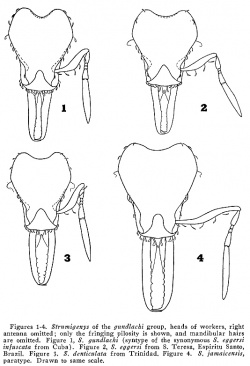Strumigenys jamaicensis
| Strumigenys jamaicensis | |
|---|---|

| |
| Scientific classification | |
| Kingdom: | Animalia |
| Phylum: | Arthropoda |
| Class: | Insecta |
| Order: | Hymenoptera |
| Family: | Formicidae |
| Subfamily: | Myrmicinae |
| Tribe: | Attini |
| Genus: | Strumigenys |
| Species: | S. jamaicensis |
| Binomial name | |
| Strumigenys jamaicensis Brown, 1959 | |
Known from a few collections showing this is likely a mountain forest species. It has been found using ground sampling methods.
Identification
Bolton (2000) - A member of the gundlachi-complex in the Strumigenys gundlachi group. Easily distinguished from its closest relatives (defined under Strumigenys gundlachi) by its relatively large ventral postpetiolar lobe (much larger than in gundlachi) and strongly developed preapical dentition (in gundlachi preapical denticles are tiny and inconspicuous). A species as darkly coloured as jamaicensis, Strumigenys enopla, is known from high altitude in Colombia. This differs from jamaicensis as in enopla the head is narrower (CI 72 - 78) and the scape longer (SI 83 - 100). Also, in enopla the ventral and lateral postpetiolar lobes are tiny and the spongiform pad at the base of the first gastral sternite is vestigial to absent.
Keys including this Species
Distribution
Latitudinal Distribution Pattern
Latitudinal Range: 18.2° to 18.083°.
| North Temperate |
North Subtropical |
Tropical | South Subtropical |
South Temperate |
- Source: AntMaps
Distribution based on Regional Taxon Lists
Neotropical Region: Greater Antilles, Jamaica (type locality).
Distribution based on AntMaps
Distribution based on AntWeb specimens
Check data from AntWeb
Countries Occupied
| Number of countries occupied by this species based on AntWiki Regional Taxon Lists. In general, fewer countries occupied indicates a narrower range, while more countries indicates a more widespread species. |

|
Estimated Abundance
| Relative abundance based on number of AntMaps records per species (this species within the purple bar). Fewer records (to the left) indicates a less abundant/encountered species while more records (to the right) indicates more abundant/encountered species. |

|
Biology
Castes
Nomenclature
The following information is derived from Barry Bolton's Online Catalogue of the Ants of the World.
- jamaicensis. Strumigenys jamaicensis Brown, 1959c: 6 (w.) JAMAICA. Combination in Pyramica: Bolton, 1999: 1673; in Strumigenys: Baroni Urbani & De Andrade, 2007: 122. See also: Brown, 1960b: 45; Bolton, 2000: 188.
Unless otherwise noted the text for the remainder of this section is reported from the publication that includes the original description.
Description
Worker
TL 2.1-2.6, HL 0.48-0.56, HW 0.40-0.45, CI 81-86, ML 0.28-0.42, MI 59-77, SL 0.26-0.35, SI 65-80, PW 0.24-0.28, AL 0.53-0.58 (10 measured). Characters of gundlachi complex; see also notes under Strumigenys gundlachi. Inner margin of mandible with 6 - 12 conspicuous strong triangular preapical denticles, located along the apical two-thirds or more of the length. Spongiform appendages present and distinct on postpetiole, in profile the ventral lobe about equal in height to the height of exposed cuticle on the side of the node. First gastral tergite smooth and shining when clean, without dense reticulate sculpture. Colour blackish-brown to black.
Type Material
Holotype worker and paratype workers, JAMAICA: St Thomas Parish, Com Puss Gap, ca 2000 ft (H. B. Mills); paratype workers, JAMAICA: Portland Parish, Hardwar Gap, ca 4000 ft (Mills) (Illinois Natural History Survey Insect Collection, Museum of Comparative Zoology) (examined).
References
- Baroni Urbani, C. & De Andrade, M.L. 2007. The ant tribe Dacetini: limits and constituent genera, with descriptions of new species. Annali del Museo Civico di Storia Naturale “G. Doria” 99:1-191.
- Bolton, B. 1999. Ant genera of the tribe Dacetonini (Hymenoptera: Formicidae). J. Nat. Hist. 33:1639-1689. (page 1673, Combination in Pyramica)
- Bolton, B. 2000. The ant tribe Dacetini. Memoirs of the American Entomological Institute. 65:1-1028. (page 188, redescription of worker)
- Brown, W. L., Jr. 1959c. Some new species of dacetine ants. Breviora. 108:1-11. (page 6, worker described)
- Brown, W. L., Jr. 1960c [1959]. The neotropical species of the ant genus Strumigenys Fr. Smith: group of gundlachi (Roger). Psyche. 66:37-52. (page 45, redescription of worker)
- Brown, W. L., Jr. 1962c. The neotropical species of the ant genus Strumigenys Fr. Smith: synopsis and keys to the species. Psyche. 69:238-267.
- [[Media:Silva, T.S.R.D., Chaul, J.C.M. et al. 2022. Lectotype designation and redescription of four commonly collected Neotropical species of Strumigenys (10.5852@ejt.2022.798.1673).pdf|Silva, T.S.R.D., Chaul, J.C.M., Feitosa, R.M. 2022. Lectotype designation and redescription of four commonly collected Neotropical species of Strumigenys (Hymenoptera: Formicidae). European Journal of Taxonomy, 798(1), 103–126 (Template:Doi.org).]]
References based on Global Ant Biodiversity Informatics
- Bolton, B. 2000. The Ant Tribe Dacetini. Memoirs of the American Entomological Institute 65
- Brown W. L. Jr. 1960. The neotropical species of the ant genus Strumigenys Fr. Smith: group of gundlachi (Roger). Psyche (Cambridge) 66: 37-52.
- Brown W. L. Jr. 1962. The neotropical species of the ant genus Strumigenys Fr. Smith: synopsis and keys to the species. Psyche (Cambridge) 69: 238-267.
- Brown W. L., Jr. 1959. Some new species of dacetine ants. Breviora 108: 1-11.
- Kempf, W.W. 1972. Catalago abreviado das formigas da regiao Neotropical (Hym. Formicidae) Studia Entomologica 15(1-4).


